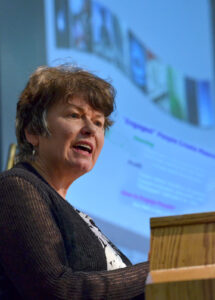Today, we are all being tested greatly, and so it is with our leaders. Individuals, organizations, and systems are all under strain, with some facing overload. Here are several keys to crisis leadership.
Radical Focus
When you are in a crisis, your immediate priority is survival. Crises require take fierce discipline in personal and organizational time management. Leaders should expect to use more “steel” (hard-edged leadership) than “velvet” (soft-edged) at the outset.
In a crisis, leaders must mercilessly cast aside all manner of ideas and projects—some with real merit—to ensure a tight focus on one or two key priorities needed for survival. Other priorities must wait. Even with this radical focus, leaders should look beyond the current storm, seeking creative ways to position the organization or group to flourish once the storm has passed.
Communicating Reality and Confidence
During a crisis, people need to know what is happening. Effective communications are essential, and it is imperative that the executive is factually accurate and forthright.
Leaders should block their calendar daily for time with their team and other key stakeholders. They must be visibly present inside and outside the organization—using all available technologies to enhance access.
Since people are stressed and worried as rumors fly, leaders must give people a sense of what to expect in the coming days and weeks, blending both realism about the current situation and confidence about the future if wise and bold action is taken.
It is essential to listen carefully and answer questions honestly. People need to be heard, and they deserve a realistic assessment of the situation and want solutions (or credible plans for how to get them). Credibility is a tremendous asset for the hard work ahead and must not be squandered.
Psychological Stability
In a crisis, many people are afraid, upset, or angry. The executive must establish not only financial and operational stability but also psychological stability. People need to be unfrozen, empowered to do what is required with confidence. Here is a tried and true five-step process for establishing psychological stability:
- Ventilation. First, identify all the problems. Go around the table, with each person briefly stating one issue—whether major or trivial and without editorial comment—or passing. Stop when everyone around the table has passed three times in a row. Be sure to document all the issues raised so people know they have been heard.
- Priorities. Then sort the issues into topics (e.g., financial, operational, safety) and rank them as A, B, or C priorities.
- Projects. Then form a crack team to work on the A priorities. The Bs are placed into a holding area, awaiting progress on the As. The Cs are deferred. The executive should require weekly (or daily) status reports to the senior management team on the A priorities, thereby establishing both transparency and accountability.
- Values. The executive must then emphasize the need to operate by shared values.
- Amnesty. Before moving forward, wise executives recognize that progress is not possible if people maintain vendettas about past grievances or play the “blame game.” To move forward, everybody must agree to provide amnesty for all prior mistakes. No grudges. The focus must be on the present and future, not the past.
Crisis Response Team
Facilitating the process above, the executive will get a sense for who would be reliable officers in the stormy seas ahead and who would be dead weight.
Selecting the crisis response team (and its associated roles and processes) is one of the most important things a leader can do. Skill set, character, emotional intelligence, resilience, courage, and buy-in with the shared values are good criteria to use in selecting the team. An effective organizational structure with clear roles and responsibilities, reporting lines, and communication channels are all required.
Operating Rhythm
A real risk in crises is that the initial momentum fizzles, causing the enterprise to spiral down again. To maintain forward momentum, leaders must establish a persistent operating rhythm with accountability follow-ups. Regular status reports and town hall meetings with employees (or constituents) are important.
The effort requires persistence. The group must hack away at the root causes of the problems, not symptoms. Together, they make slow and steady progress over time, reporting results and encouraging each other. Such feedback loops help foster alignment.
“A river cuts through rock, not because of its power, but because of its persistence.”
-James Watkins, author
Sanctuary
In crises, leaders receive a barrage of body blows. To survive such an onslaught and to remain at their best, leaders need a daily practice of sanctuary to refresh mind, body, and spirit. Leaders must not lose themselves in their role, taking the inevitable attacks and setbacks personally.
“In moments of darkness you need to remember why you’re here and why you’re fighting that fight.”
-Jacqueline Ros, co-founder and CEO of Revolar
Triple Crown Leadership Practices
Finally, the five “triple crown leadership” practices that are key to building excellent, ethical, and enduring organizations are all applicable to crises:
- Head and Heart. Choose people not only with the “head” elements of skills sets but also with the “heart” elements of character, emotional intelligence, and cultural fit.
- The Colors. Commit to uphold the shared purpose, values, and vision.
- Steel and Velvet. Flex between the hard and soft edges of leadership. Leaders should invoke steel to hold people accountable for the values and priorities but be careful not to squelch the initiative of potential leaders in the ranks.
- Stewards. Unleash multiple leaders to serve as stewards of the culture. Most crises require a great team of leaders, not a lone visionary.
- Alignment. Achieve peak performance through disciplined, collaborative alignment, with clear action plans, accountability mechanisms, and feedback loops.
Tools for You
- Traps Test (Common Traps of Living) to help you identify what’s getting in the way of your happiness and quality of life
- Quality of Life Assessment to help you discover your strongest areas and the areas that need work and then act accordingly
- Personal Values Exercise to help you clarify what’s most important to you
Related Articles
- “Is Your Organization Headed for a Breakdown?“
- “How to Come Back Even Stronger from a Crisis“
- “Renewing Yourself Amidst the Chaos“
- “How Leaders Should Address the Unique Challenges of Our Times“
- “Is Your Organization Aligned?“
- “How to Align Your Organization for Peak Performance“
- “Is Your Business Stuck in Zombieland?“
Additional Tips on Crisis Leadership
- Be wary of “the greatest leadership sin of all–hubris.” -James Kouzes and Barry Posner, A Leader’s Legacy
- “You can’t surrender to the options before you. There’s always another way.” -Cory Booker, civic entrepreneur, U.S. senator
- “People always ask me, ‘What’s the secret to being a successful CEO?’ Sadly, there is no secret, but if there is one skill that stands out, it’s the ability to focus and make the best move when there are no good moves. It’s the moments where you feel most like hiding or dying that you can make the biggest difference as a CEO.” -Ben Horowitz, entrepreneur, inventor, investor
- “The signature of the truly great versus the merely successful is not the absence of difficulty, but the ability to come back from setbacks, even cataclysmic catastrophes, stronger than before.” -Jim Collins, How the Mighty Fall
++++++++++++++++++++++++++++++
Gregg Vanourek is a writer, teacher, TEDx speaker, and coach on leadership and personal development. He is co-author of three books, including LIFE Entrepreneurs: Ordinary People Creating Extraordinary Lives (a manifesto for integrating our life and work with purpose, passion, and contribution) and Triple Crown Leadership: Building Excellent, Ethical, and Enduring Organizations (a winner of the International Book Awards). Check out his Best Articles or get his monthly newsletter. If you found value in this article, please forward it to a friend. Every little bit helps!











